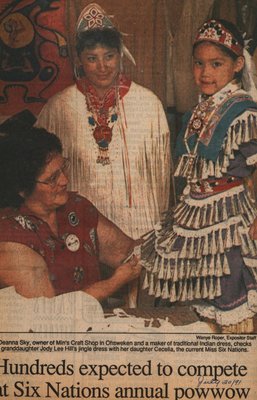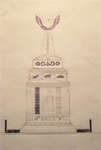"Hundreds Expected to Compete at Six Nations Annual Powwow"
- Publication
- Brantford Expositor, 20 Jul 1991
- Full Text
- Hundreds expected to compete at Six Nations annual powwow
The Mohawk man believes the powwow is a modern-day version of traditional trading festivals, where Iroquois nations and their allies traded goods, held political discussions and joined in inter-tribal dancing.
Art Solomon, an Ojibwa elder and author who lives near Sudbury, said his people did have a traditional summer festival.
The Ojibwas split up into small groups through the winter to find food and trap for furs. When summer arrived the families would drift back to the community "and then there was a need for celebration."
Jake Thomas, a traditional Cayuga chief who has taught native studies at Trent University for 14 years, says the powwow was borrowed from the Plains Indians, who used to have ceremonies involving dancing in preparation for hunting expeditions, warfare and other important events.
The Iroquois ceremonies, held throughout the year to give thanks to the earth and the Creator, cannot be incorporated into the powwows, he said.
"The elders were always against some things in the powwow because there was so much competition," and it was all for money.
Traditional longhouse beliefs stress that singing and dancing are gifts from the Creator and they should be used for the benefit of the community rather than for personal gain.
Some bands, such as the Mississaugas of the New Credit, have decided against the big-budget, competitive powwows in favor of smaller, more traditional gatherings.
Dancing is only a small part of the two-day event. In the mornings there are teaching circles and ceremonies for the native people.
In the evenings, speakers discuss issues which will help everyone learn more about the Ojibwa culture.
The band also hosts a big feast, as a "thank you" to all who attend. Gas money is provided to help offset travel costs of participants.
Powwow songs started by PlainsThe word "powwow" comes from the Algonquin word for a curing ceremony, pauau.
Non-natives who witnessed this religious event mistakenly used "powwow" to describe any large gathering of Indian people.
Most of the songs originated with the Plains people, in their own tongue. The lyrics often told of heroic deeds and of battles won or lost.
When other Indian nations adopted the songs, they had little knowledge of the original language and often invented meaningless syllables to replace the words.
These 'vocables' now dominate the songs at powwows, though they are sometimes mixed in with passages in the original language, or in the language spoken by drummers.
The costumes are different for each of the main dancing styles in competitive powwows.
The costumes and main styles of dance will be demonstrated this weekend during the annual Grand River Champion of Champions Powwow at Chiefswood Park on Highway 54.
The 12th annual event opens at 11:30 a.m. on Saturday and Sunday with dancing, entry parade and displays of arts and crafts.
TraditionalTraditional dancers tap-step along the ground in a slow, stately rhythm, and the men often depict an old legend or the hunt.
The feet of female traditional dancers never fully leave the ground, to symbolize their ties with the earth.
The outfits incorporate items such as furs, feathers and the heads of small animals.
Fancy dancingA relatively new form of dancing, where dancers twist and spin in rapid beats, blend more traditional moves with such contemporary styles as break dancing.
Women usually wear a bright colored satin-like dress or a more traditional-styled buckskin outfit, topped by a colorful shawl.
Men's outfits are an extravagant mix of the brightest feathers and bead work.
Grass danceThe grass dance is one of the oldest performed at the powwow. Traditionally, it was a warrior's dance in which only members of the grass dance society were allowed to perform.
It is believed to have originated from the Pawnee, in the mid-western United States, when dancers gathered to beat down the grass for events.
It is performed only by men, who wear brightly colored headgear and outfits made of colorful bits of yarn and leather.
Jingle danceThis style, performed only by women, originated with the Ojibwa people. The outfits are made of shiny cones which jingle when they move. The dance involves sliding, shuffling and a fast sidestep.
- Media Type
- Newspaper
- Publication
- Item Types
- Articles
- Clippings
- Description
- "Hundreds expected to compete at Six Nations annual powwow."
- Date of Publication
- 20 Jul 1991
- Subject(s)
- Personal Name(s)
- Sky, Deanna ; Hill, Jody Lee ; Hill, Cecelia.
- Corporate Name(s)
- Min's Craft Shop.
- Local identifier
- SNPL003053v00d
- Collection
- Scrapbook #3
- Language of Item
- English
- Geographic Coverage
-
-
Ontario, Canada
Latitude: 43.06681 Longitude: -80.11635
-
- Creative Commons licence
 [more details]
[more details]- Copyright Statement
- Public domain: Copyright has expired according to Canadian law. No restrictions on use.
- Copyright Date
- 1991
- Contact
- Six Nations Public LibraryEmail:info@snpl.ca
Website:
Agency street/mail address:1679 Chiefswood Rd
PO Box 149
Ohsweken, ON N0A 1M0
519-445-2954



